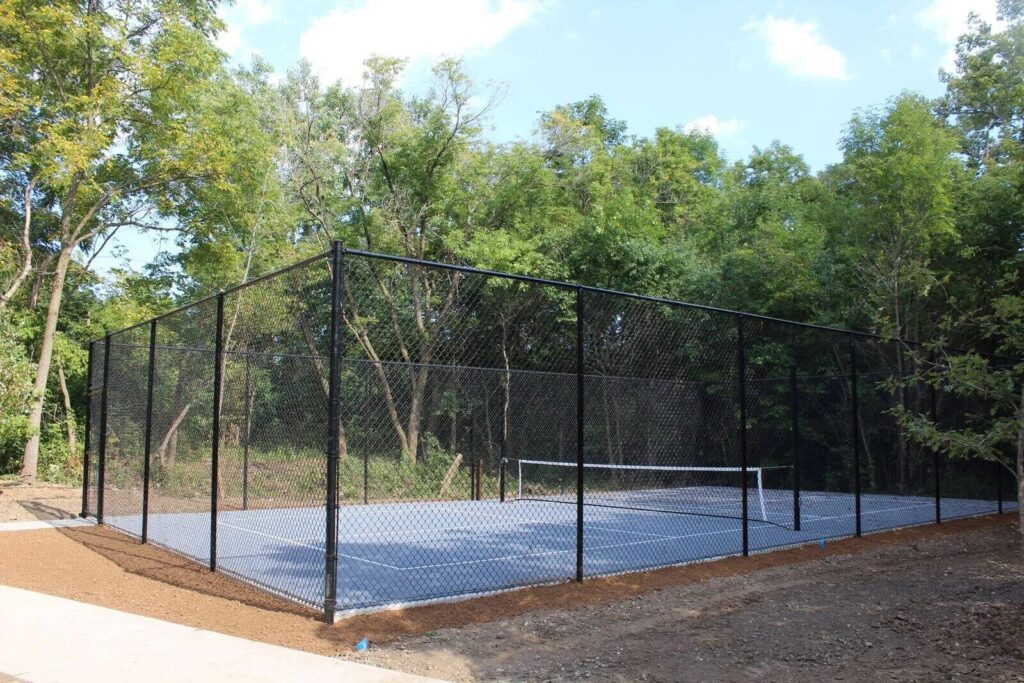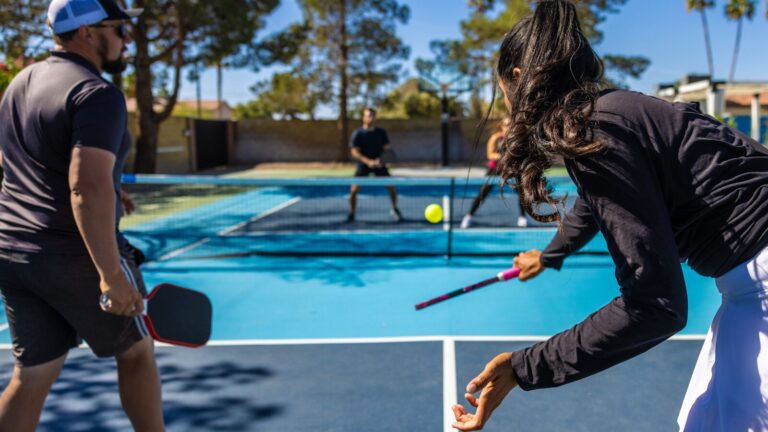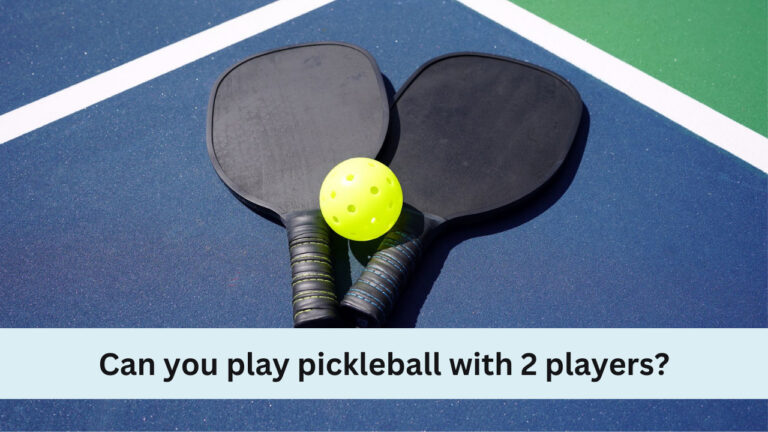How to build a pickleball court in your backyard – Step by Step Guide (2024)
Interested to know “How to build a pickleball court in your backyard”. Creating a pickleball court at home offers a fantastic opportunity to maintain an active lifestyle. In this article, we will find the answer to the question: “How to build a pickleball court in your backyard?”
To construct a pickleball court in your backyard, begin by planning the layout and dimensions. Choose appropriate surfacing materials, such as asphalt or concrete, and proceed to install fencing and net posts. This comprehensive guide will walk you through the essential steps and considerations for successfully building a pickleball court in your backyard. So, let’s have a look at “How to build a pickleball court in your backyard”:
How to build a pickleball court in your backyard?
When we are thinking of How to build a pickleball court in your backyard? Then its important to follow size, surface and set up. These three points are the main base of building a pickleball court in your backyard:
Here are the essential steps that will answer our very first question: How to build a pickleball court in your backyard:
Step 1: Check the Size
The dimensions of a backyard pickleball court typically measure 20 feet by 44 feet, ensuring a suitable playing area. It’s essential to account for additional space around the court to prevent any mishaps during intense gameplay. According to the USAPA rulebook, the recommended minimum total play area is 30 feet by 60 feet, with an ideal 10-foot surrounding margin.

This results in a preferred total playing surface of 40 feet by 64 feet. Optimal court orientation is north to south, taking advantage of the sun’s direction to avoid glare in the players’ eyes. However, this may vary based on the yard’s layout, considering factors like existing shade from tall trees that could naturally cover the court.
Step 2: Check Local Regulations
Checking local regulations is a crucial step before constructing a pickleball court in your backyard. You need to understand the zoning regulations for your property. Some areas may have restrictions on the types of structures or land use allowed in residential zones. You need to Inquire about the need for building permits. Even for a backyard sports court, you may need to obtain the appropriate permits from the local building department.
Before going to check local regulations, it is important to check setback requirements, which dictate how far structures must be from property lines. Ensure that your court location complies with these regulations. Be aware of any environmental considerations. Some areas may have regulations regarding the impact of construction on the environment, such as water runoff or habitat disruption.
Here are some guidelines on how to check local regulations:
First: Contact Local Authorities
Reach out to your local city or county planning department. They can provide information on zoning regulations, building permits, and any other requirements for sports court construction.
Second: Homeowner’s Association (HOA)
If you live in a community with a homeowner’s association, check their guidelines. Some HOAs may have specific rules about adding structures like sports courts to your property.
Third: Neighbour Notifications
Some localities may require you to notify your neighbors about your construction plans. This is more common in densely populated areas.
Fourth: Land Use Restrictions
Understand any specific land use restrictions in your area. Certain neighborhoods or subdivisions may have covenants or restrictions that govern what you can build on your property.
Fifth: Historical Districts
If your property is in a historical district, additional restrictions may apply. Check with local preservation authorities to ensure compliance.
Sixth: Safety Codes
Ensure that your project complies with safety codes and standards. This may include considerations for fencing, Lighting, and other safety measures.
Step 3: Selecting the Ideal Location for Your Backyard Court
When determining the optimal location for your backyard pickleball court, consider the following tips. Ensure ample space to accommodate the court’s standard size, leaving extra room for players to move freely. Opt for a flat area to minimize the risk of accidents and ensure a seamless gaming experience. Seek a location with the right amount of sunlight, or consider adding shade for enhanced comfort.
Choose a tranquil spot distanced from noisy streets or neighbours. Additionally, ensures convenient accessibility for everyone, with nearby parking and easily accessible entry points. These factors will contribute to establishing an ideal playing area, ensuring enjoyable pickleball games right at home.
Step 4: Gather Essential Materials and Equipment for Construction
To construct a pickleball court, gather the following materials:
| Material | Guidelines |
| Surface Material | Choose a suitable surface material like asphalt or concrete. Both materials offer durability and provide an excellent playing surface. |
| Fencing | Install fencing around the court to keep the ball in play and ensure a safe playing environment. A standard fence height of at least 10 feet is recommended. |
| Court Markings | Use durable paint to mark the court boundaries, including the baseline, sidelines, non-volley zone (kitchen), and service courts. |
| Net and Posts | Invest in a quality pickleball net and sturdy posts. The net should be 34 inches in height at the sidelines and 36 inches at the center. |
Step 5: Prepare The Ground

By following these detailed steps, you’ll not only prepare a solid foundation for your pickleball court but also ensure its ongoing maintenance and potential upgrades for years of recreational enjoyment.
- Clear the Area: Start by thoroughly clearing the designated court area. Remove any debris, rocks, roots, or vegetation that might interfere with the court’s foundation. This initial step is essential to create a clean slate for building your pickleball court.
- Level the Ground: Using a shovel or grading tool, level the ground to ensure an even surface. Remove any major bumps or depressions that could compromise the court’s smoothness. This step is crucial for providing a stable foundation for the court construction.
- Compact the Soil: Once the ground is levelled, use a soil compactor or heavy roller to compact the soil. Compacting the soil in layers helps achieve optimal density, enhancing the stability of the court. Proper compaction also minimizes the risk of settling over time.
- Add a Base Material (if necessary): Consider adding a suitable base material depending on your chosen court surface (asphalt or concrete). Gravel or crushed stone can improve drainage and provide additional stability. Ensure proper compaction of the base material for a solid foundation.
- Ensure Proper Sloping: To prevent water accumulation, create a slight slope away from the centre of the court. Proper sloping promotes adequate water drainage, preventing issues such as waterlogging that could harm the court surface in the long run.
- Professional Installation (for asphalt or concrete): If opting for asphalt or concrete, it’s advisable to hire professionals for Installation. Their expertise ensures the correct thickness and composition, resulting in a durable and long-lasting pickleball court.
- Allow for Proper Curing (for concrete): If concrete is the chosen surface, allow it to cure properly before any further steps. Follow the manufacturer’s guidelines for curing time to achieve optimal strength and performance.
Step 6: Install Fencing

- Choose Suitable Fencing: Select fencing materials that are durable and appropriate for outdoor use. A standard fence height of at least 10 feet is recommended to contain the pickleball and ensure a safe playing environment.
- Install Fence Posts: Secure sturdy fence posts around the court perimeter. Properly anchored posts are essential for the stability and longevity of the fencing. Ensure that the posts are evenly spaced and aligned for a professional finish.
- Attach the Fencing: Once the posts are in place, attach the fencing securely. Ensure that the fencing is taut and properly tensioned to prevent sagging. This step is crucial for maintaining the integrity of the court boundaries during gameplay.
- Maintaining And Upgrading Your Backyard Pickleball Court
- Regular Cleaning: Implement a routine cleaning schedule to remove debris, leaves, and other materials from the court surface. Regular cleaning prevents damage and ensures a consistent playing experience.
- Inspect and Repair: Regularly inspect the court for signs of wear and tear. Repair any cracks or damage promptly to prevent further deterioration. Addressing issues early on can extend the life of your pickleball court.
- Resurfacing (as needed): Depending on the court surface material, consider resurfacing every few years to maintain a smooth playing surface. Follow manufacturer recommendations for resurfacing products and techniques.
- Upgrading Accessories: Consider upgrading accessories such as nets and posts if they show signs of wear. Quality equipment enhances gameplay and ensures a safe and enjoyable experience for players.
- Enhance Lighting (optional): If you enjoy playing in the evening, consider installing outdoor Lighting around the court. Proper Lighting enhances visibility and extends the hours of play, providing more opportunities to enjoy your backyard pickleball court.
Step 7: Install the Pickleball Net system

When it comes to installing a pickleball net system, the process begins with assessing your space, the type of surface you have, and the materials used for your court. Once these factors are determined, the next step is to reach out to an expert who can guide you in choosing the right pickleball net system for your needs.
There are various types of pickleball poles and systems, each with unique characteristics. If your court is outdoors, it’s essential to select a system designed to endure outdoor conditions. A complete outdoor pickleball net system typically consists of two poles, a ratchet, an outdoor pickleball net, and sleeves, which may or may not be required depending on the specific system. This thoughtful selection ensures durability and optimal performance for your pickleball program.
This comprehensive video will guide you more on “How to build a pickleball court in your backyard”
Hire a builder for building a pickleball court in backyard
When considering the construction of a pickleball court in your backyard, hiring a professional builder can be a game-changer. A skilled builder brings expertise in ensuring the court’s dimensions adhere to regulations and optimizing the layout for a seamless playing experience. From preparing the ground to installing the appropriate fencing, net systems, and surface materials, a builder streamlines the process, saving you time and effort. Their knowledge extends to factors like proper drainage, sun orientation, and creating a safe, level playing surface. By entrusting the project to a builder, you not only enhance the overall quality of the court but also ensure it becomes a well-crafted and durable space for enjoyable pickleball matches right in the comfort of your backyard.
Total Cost Estimate to Construct a Backyard Pickleball Court
For a primary backyard pickleball court, you can expect to spend between $10,000 and $25,000 or more. This estimate includes surface material, fencing, net, posts, court markings, and installation labor. The final cost can vary based on your location, material choices, and any additional features.
Conclusion
Keep in mind that these are general estimates, and costs may vary based on regional factors, the complexity of the project, and individual preferences. Obtaining multiple quotes from contractors and suppliers in your area is recommended to get a more accurate estimate for your specific situation.
Creating a pickleball court in your backyard is an exciting project that promises fun and fitness steps away from home. This guide on “How to Build a Pickleball Court in Your Backyard” provides a detailed roadmap, covering critical aspects from ground preparation to estimated costs.
By understanding the essentials of ground leveling, fencing installation, and ongoing maintenance, you’re well-prepared to turn your outdoor space into a personalized pickleball haven. This investment not only
enhances your property but also fosters a sense of community and active living.
So, hang out into the process, gather your materials, and enjoy the thrill of playing pickleball in your backyard. Your court isn’t just a playing surface; it’s a space for creating cherished memories and embracing the joy of the game right at home!
FAQs
What are the dimensions of a standard backyard pickleball court?
A standard backyard pickleball court measures 20 feet by 44 feet for both singles and doubles play. The court is divided into left and right service courts by a centerline.
How much does it cost to build a pickleball court in my backyard?
The cost of building a backyard pickleball court can vary based on factors like surface material, fencing, and installation labor. On average, you can expect to spend between $10,000 and $25,000 or more, depending on your preferences and location.
Can I build a pickleball court on my own, or should I hire professionals?
While some DIY enthusiasts may attempt to build a pickleball court themselves, it’s often recommended to hire professionals for tasks like ground preparation and surface installation. Professionals ensure proper construction, enhancing the longevity and playability of the court.




![What shoes to wear for pickleball - An Expert Analysis [2024 guide] 9 What shoes to wear for pickleball - An Expert Analysis [2024 guide]](https://choosepickleballs.com/wp-content/uploads/2024/01/ghi-pickleballshoe-64763441ed1fd-768x384.jpg)



3 Comments
Comments are closed.